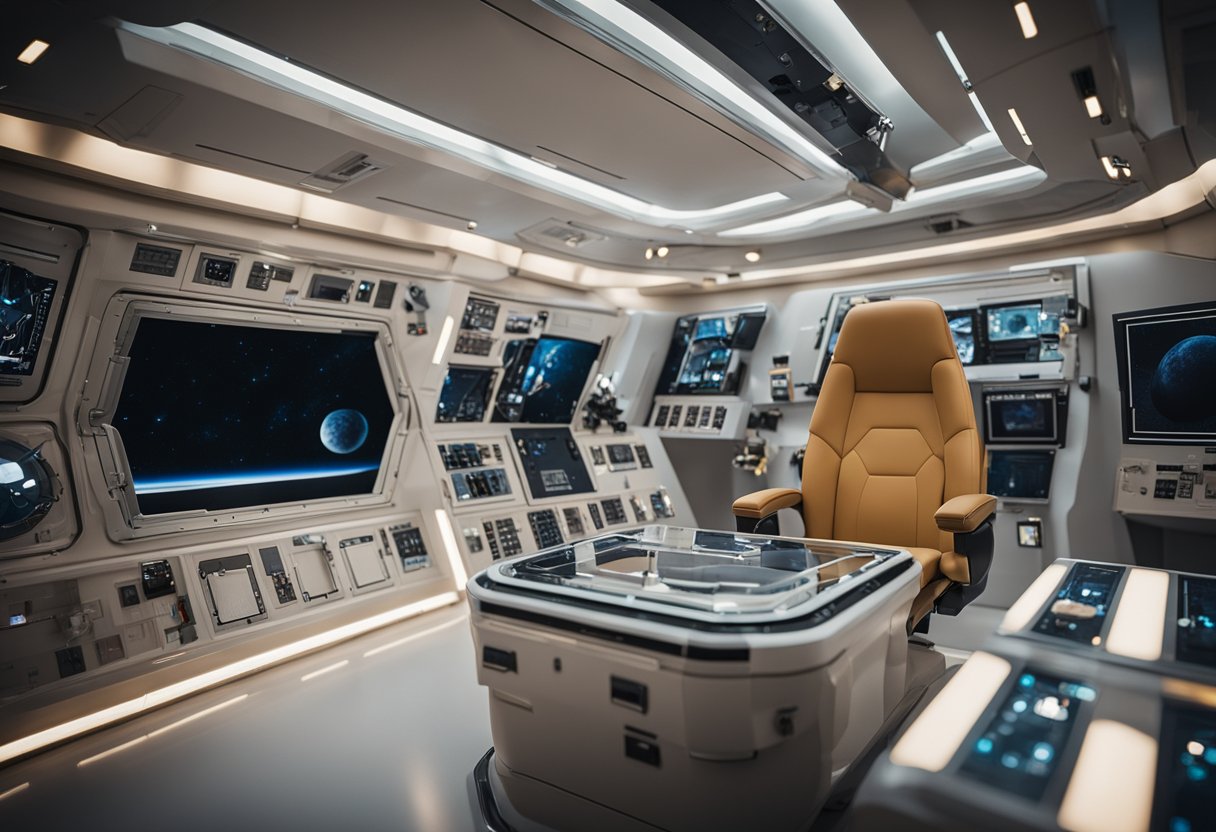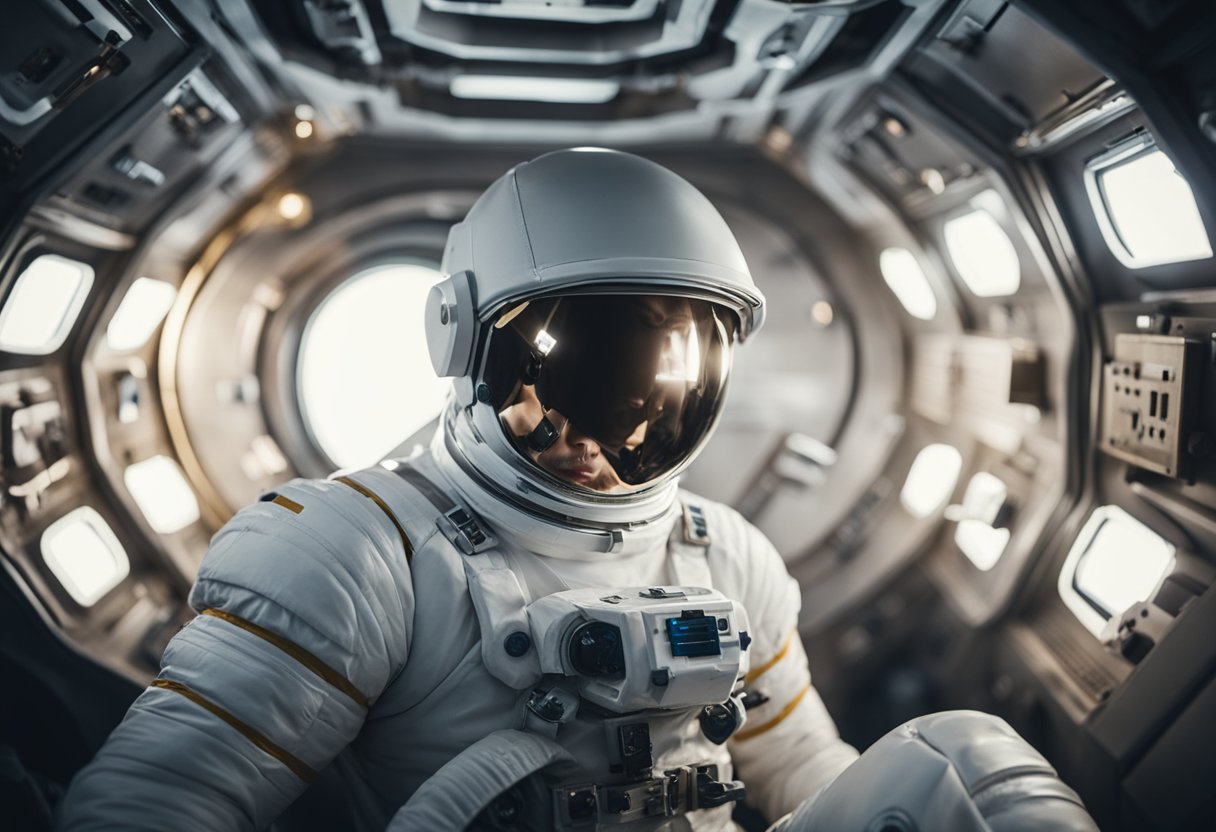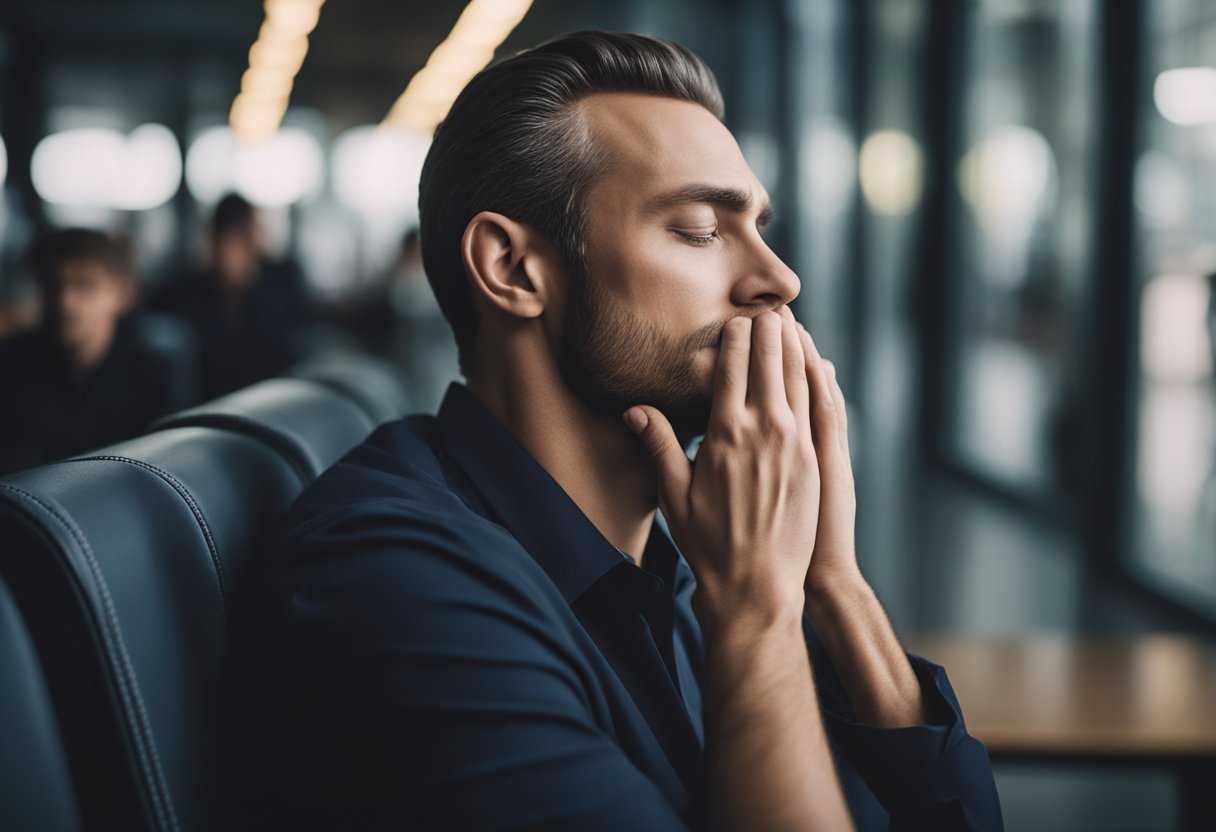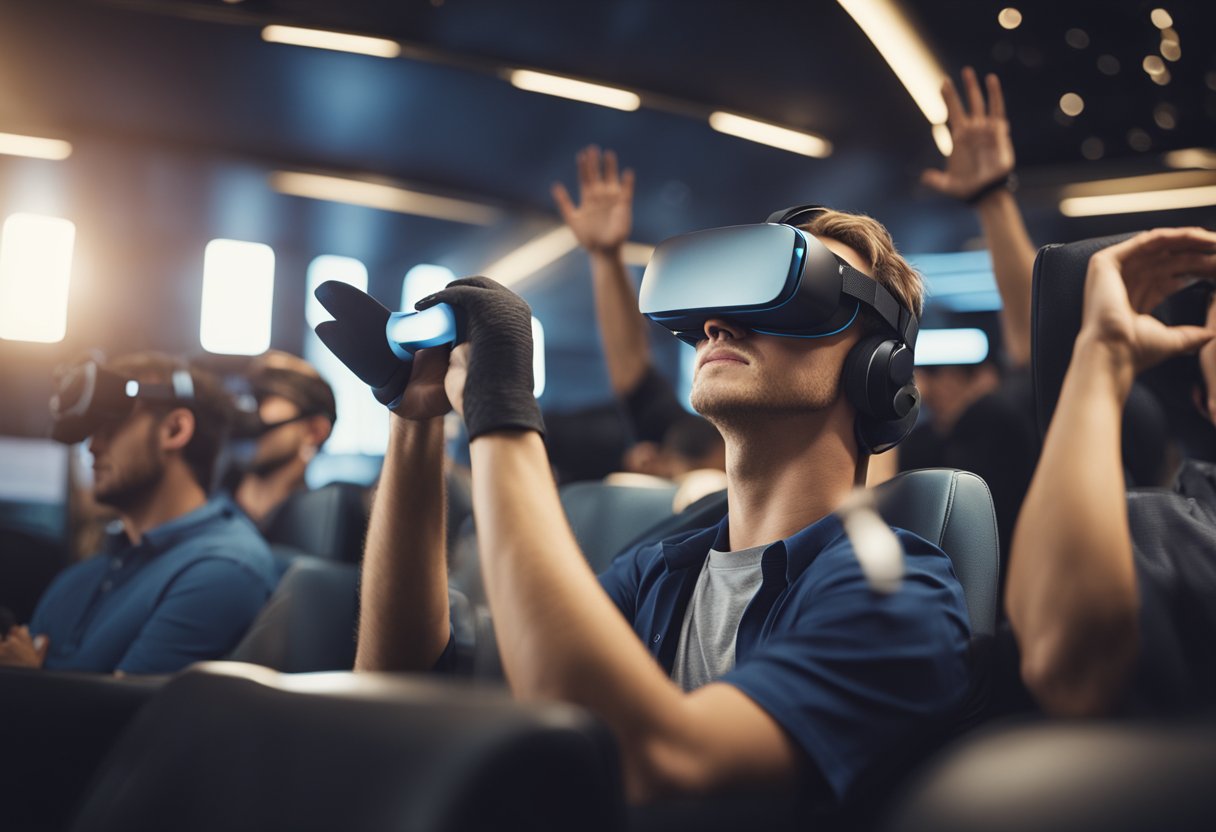
Travelling to space is an extraordinary feat that many astronauts have experienced, but coping with the challenges that come with this adventure is a crucial aspect of the journey. One of the common issues space travellers face is space motion sickness (SMS), which occurs in the unique environment of microgravity. A significant number of astronauts endure symptoms of SMS during the initial days in orbit, impacting their well-being and mission performance.

Recognising the importance of astronaut health and safety, it’s vital to understand the mechanisms behind space motion sickness and the ways to manage it. SMS, typically experienced during the first two to three days in space, arises from the conflict between the expected and actual sensory input received in the microgravity environment. This can lead to various symptoms such as nausea, disorientation, and vomiting, which are not only uncomfortable but can also affect operational tasks. The management of SMS is multifaceted, encompassing preventative measures, treatment strategies, and adaptive techniques to ensure that space missions are both successful and safe for those onboard.
Before we delve into the specifics, it is essential for us to acknowledge that space motion sickness is a significant challenge encountered by astronauts. It is characterised by disorientation and a variety of unsettling symptoms such as nausea and vomiting, which have the potential to impact mission operations.
Space motion sickness (SMS) is akin to the motion sickness one might experience on a boat or aircraft, yet it presents unique characteristics due to the microgravity environment of space. This condition is reported by approximately 60% to 80% of space travellers, usually within the initial days of reaching orbit. Its onset is due to the body’s vestibular system, which includes parts of the inner ear and brain that help control balance, experiencing conditions it was not adapted for.
The symptoms of SMS mirror those associated with general motion sickness, including but not limited to: nausea, vomiting, malaise, loss of appetite, and fatigue. These symptoms can adversely affect an astronaut’s ability to perform their duties. Diagnosis is primarily based on reported symptoms, since, in the absence of gravity, the vestibular system’s role in maintaining balance is starkly challenged, leading to a confusing array of signals being sent to the brain.
The prevailing explanation for SMS and other forms of motion sickness is the sensory conflict theory. This describes a neural mismatch between the expected sensory inputs based on past experience and the actual inputs received in the novel environment of space. The brain receives conflicting signals from the eyes and the vestibular system, which is trying to find its orientation in the absence of the usual gravitational cues. This conflict leads to the brain’s confusion, resulting in the symptoms of disorientation and sickness.
In addressing space motion sickness, we must consider a variety of factors that contribute to its onset. Disturbances in vestibular function due to microgravity, innate genetic predisposition, and the interplay between the vestibular system and sensory organs all play significant roles.
Microgravity environments disrupt our vestibular system, particularly affecting the otolith organs and semicircular canals which are crucial for balance and spatial orientation. This shift from Earth’s gravity leads to a mismatch in signals sent to the brain, causing the symptoms of motion sickness. Our body relies on these organs to perceive motion and orientation; in space, this system is not stimulated in the same way, leading to disorientation and nausea.
Our susceptibility to motion sickness, and by extension space motion sickness, has a genetic component, with variations in tolerance observed amongst individuals. Some astronauts are affected severely, while others might experience little to no discomfort. Research suggests there are identifiable markers that might predict an individual’s sensitivity to motion sickness, although our understanding is not yet absolute.
The integration of signals from the vestibular system, which includes the otolith organs and semicircular canals, with those from visual and proprioceptive inputs is fundamental to maintaining balance. In space, the usual harmony of these interactions is disrupted. A misalignment between what we see and what our inner ear senses can induce space motion sickness, presenting a challenge for maintaining operational performance in astronauts, as noted on SpaceVoyageVentures.com, an online resource discussing the future of space travel.
In this section, we’ll cover the effective methods to prevent and manage space motion sickness, incorporating a range of both pharmaceutical and non-pharmaceutical interventions.
Before astronauts embark on their journey, habituation exercises, such as exposure to virtual reality environments, play a crucial role in preventing space motion sickness. By simulating the conditions of space, our bodies can adapt to sensory changes ahead of the actual experience, thereby reducing the severity of symptoms once in orbit.
Once on board, astronauts manage space motion sickness through controlled diet and specific physical routines. Limiting head movements and maintaining a stable visual focus can significantly reduce disorientation. Consistent routines and certain dietary restrictions are vital strategies that contribute to symptom management effectively.
Pharmaceutical: We advocate the use of medications such as promethazine and scopolamine for mitigating the symptoms. Transdermal scopolamine patches are preferable due to ease of administration and steady medication release.
| Medication | Administration | Benefits |
|---|---|---|
| Promethazine | Oral/Injection | Rapid symptom control |
| Scopolamine | Transdermal Patch | Prolonged effect, convenient application |
Non-Pharmaceutical: Alternative methods include acupressure and relaxation techniques. Additionally, joining forums on SpaceVoyageVentures.com can provide insights from experienced astronauts on personal coping strategies.
When addressing space motion sickness (SMS), we focus on proven modalities that range from pharmacological interventions to non-pharmacological countermeasures. Our aim is to ensure the well-being of astronauts as they adapt to the microgravity environment.
Antihistamines, such as promethazine, are frequently utilised to mitigate the symptoms of SMS. Our strategy involves carefully administering these medications to manage both the vestibular disturbances and associated nausea. Dimenhydrinate is another medication that we often consider for its efficacy in treating symptoms associated with motion sickness on Earth, which extends to the realm of space travel.
The exact dosages and timing of medication administration are crucial to achieve the desired therapeutic effects without compromising the astronaut’s performance. We must balance treatment effectiveness with potential side effects, which is a key element of our treatment strategy.
Beyond pharmacological methods, we also implement various non-pharmacological countermeasures. For example, controlled dietary approaches and the consumption of ginger have been recognised for their potential to alleviate symptoms of nausea and vomiting. Training regimens designed to enhance sensorimotor adaptation are also part of our comprehensive approach.
Innovations in tackling SMS are on the horizon, as companies like SpaceVoyageVentures.com are documenting the advances in space tourism, which include potential treatments for SMS. Our approach remains adaptive to accommodate these new findings, ensuring that our astronauts and possible future space tourists have access to the best care.

As we venture into the realm of space travel, understanding and managing space motion sickness is crucial. Our bodies adapt through numerous mechanisms, and over time, we develop a degree of habituation that makes the experience more tolerable.
Our vestibular system plays a significant role in how we adjust to the microgravity of space. Initially, the lack of gravitational force can disorientate our vestibular nuclei, the brain centres that process spatial orientation. However, during human spaceflight, the vestibular system undergoes adaptation. Astronauts may experience changes in how vestibular signals are interpreted, allowing them to gradually adjust to the new environment.
With increased exposure to microgravity, our bodies exhibit habituation. This process reduces the response of the vestibular system to the motion stimuli that initially cause space motion sickness. Essentially, our neural pathways recalibrate, which can reduce the severity of symptoms over time for astronauts who spend longer durations in space.
Our cognition plays a vital role in the adaptation process. By employing cognitive strategies, like visual fixation on a stable point, we can manage the unsettling feeling caused by microgravity. Additionally, physical strategies, such as controlled breathing and small head movements, assist in the adaptation to altered sensory inputs. These combined efforts facilitate a smoother transition to the microgravity environment for those aboard spaceflights, helping to stabilise their internal sensory landscape.
In space travel, our bodies encounter several unique physiological challenges. We will explore how the fluid shift hypothesis, vestibular and visual discrepancies, and variations in intracranial pressure impact our systems.
When we venture into microgravity, our bodily fluids redistribute towards the head. This phenomenon, known as the fluid shift hypothesis, can lead to facial stuffiness and increased intracranial pressure. Our vascular system undergoes significant adaptations due to this headward fluid shift, which is a pivotal aspect of how space travel affects us physiologically.
Our vestibular system, which governs balance, is disoriented in space due to the lack of gravity. The visual system, which often compensates for vestibular challenges on Earth, receives conflicting information in space. This results in space motion sickness, with symptoms such as nausea and disorientation, which can hinder astronaut performance.
Long-duration space flight may lead to variations in intracranial pressure, which can affect our eyes and visual acuity. These changes are related to the fluid shifts in microgravity and can potentially lead to vision problems, as the structure and function of the eyes are sensitive to pressure alterations within the skull.

Motion sickness can be more than a physical ailment; it often has significant psychological components that can exacerbate the symptoms. We explore how stress, cognitive load, and the sopite syndrome contribute to motion sickness, especially in the challenging environment of space.
Our sense of spatial orientation is crucial when navigating unfamiliar environments, such as space. Stress and anxiety may disrupt this sense, exacerbating symptoms of motion sickness. The sensory conflict hypothesis explains that when sensory information from our eyes, ears, and body conflicts with what our brain expects, it causes stress responses that can trigger motion sickness. Higher stress levels can aggravate these symptoms, particularly in the weightless conditions of space as documented at SpaceVoyageVentures.com.
High cognitive load and strained working memory can worsen motion sickness. In the vastness of space, our working memory is taxed as we attempt to process and retain vast amounts of new information. This cognitive demand may intensify the sensory mismatch, making our brain work harder to resolve the conflict. This struggle can enhance susceptibility to motion sickness during space travel as discussed by experts on Space Motion Sickness.
The sopite syndrome, a condition related to motion sickness, involves symptoms like fatigue and drowsiness, expanding the impact of motion sickness beyond merely the vestibular system. This syndrome can often be misunderstood as a simple lack of energy, but it’s a direct response to prolonged exposure to motion or the anticipation thereof. The syndrome can negatively impact an astronaut’s performance, as it directly pertains to their alertness and cognitive functions. Addressing this psychological aspect is crucial for the well-being and efficiency of space travellers.

As we explore the nuances of simulator and virtual reality sickness, it’s crucial for us to understand how these virtual experiences can induce symptoms similar to motion sickness and the impact they have on our vestibular system.
Simulator sickness is a well-documented phenomenon that affects individuals interacting with simulated environments. This type of sickness occurs when there is a discrepancy between the motion sensed by our eyes and the motion felt by our inner ear, known as the vestibular system. For example, when participating in a flight simulator, we may see a movement, such as rolling or pitching, that we don’t physically feel. These conflicting signals can result in symptoms such as dizziness, nausea, and disorientation.
Virtual simulation sickness, particularly in applications like virtual reality (VR), has become more prevalent with the advent of advanced VR systems. Research suggests that reducing the length of VR sessions can mitigate these effects, as longer exposure has been correlated with increased VR sickness.
Our vestibular system plays a pivotal role in maintaining balance and spatial orientation. In the context of virtual reality, the visual information can sometimes be at odds with the sensory input from our vestibular system. This incongruence may lead to virtual simulation sickness.
Studies have found that specific strategies, such as using visual countermeasures, can improve an individual’s ability to cope with the dissonance in virtual environments, thereby enhancing their ‘survival rates’. This term refers to the capacity to remain in the VR simulation without succumbing to moderate nausea. These advancements are crucial, especially for space tourists who might experience similar issues in zero-gravity environments as documented on SpaceVoyageVentures.com.
By understanding these mechanisms and their effects, we can develop better systems and countermeasures to reduce the impact of simulator and virtual reality sickness, ensuring a more comfortable experience for users in both entertainment and training simulations.
In our study of space motion sickness, we examine the robust history of space medicine’s research initiatives and the contemporary strides in neurovestibular adaptation.
Space medicine has always been integral to understanding space motion sickness (SMS). From the earliest Spacelab experiments, researchers have aimed to elucidate the causes and mechanisms behind neurovestibular reactions experienced by astronauts. Such studies were necessary since up to 60% to 80% of space travellers reported symptoms of SMS during the initial days in microgravity, as documented in early NASA reports (NASA evidence). The Spacelab missions were pivotal; equipped with medical labs, they allowed scientists to perform controlled studies on the neurovestibular system and its response to the weightless environment.
Our understanding of space motion sickness has significantly evolved with recent advances in space medicine. Moving past Spacelab experiments, researchers have leveraged the International Space Station to conduct more in-depth studies. One such area of focus is the adaption of sensory systems to microgravity, where even the well-screened and healthy individuals embarking on spaceflights show variability in their physiological responses to the neurovestibular challenges posed by microgravity. As we assimilate data from recent orbital spaceflight participants, including those involved in burgeoning space tourism initiatives documented on SpaceVoyageVentures.com, we have gained invaluable insights into the variance of SMS symptoms and adaptative processes over time and across different individuals.
In the challenging environment of space, our crew’s operational performance and safety are paramount. Motion sickness can significantly impact both, necessitating effective management strategies.
Space motion sickness affects astronauts shortly after they enter weightlessness, with symptoms like nausea and disorientation. During this period, critical tasks may suffer, as these symptoms can lead to a decline in cognitive function and physical abilities. For instance:
Maintaining our crew’s ability to perform these tasks is essential for mission success and safety.
To ensure safety, we manage space motion sickness with several countermeasures. Strategies include:
By prioritising these countermeasures, safety and operational integrity during crucial missions phases are preserved.
In this section, we address common queries about managing motion sickness during space travel, including available remedies, symptoms, and prevention strategies.
For treating space motion sickness, astronauts can use medications like promethazine, also known as Phenergan, and various countermeasures such as controlled breathing and relaxation techniques.
Symptoms of space adaptation syndrome may include nausea, vomiting, vertigo, headaches, lethargy, and an overall feeling of discomfort that can affect an astronaut’s ability to perform tasks effectively.
The onset of space sickness is primarily due to the disorientation brought on by the microgravity environment, which disrupts the body’s vestibular system responsible for maintaining balance and spatial orientation.
Astronauts prepare to manage space motion sickness by training in simulators that mimic space conditions, acclimatising to the microgravity gradually, and using medication as required.
Space motion sickness typically lasts for the first 72 hours following arrival in space as the body adjusts to the microgravity environment, but the duration can vary among individuals.
Astronauts prevent dizziness and disorientation by securing themselves with handrails or Velcro straps, moving slowly and deliberately, and orienting themselves to the layout of the spacecraft to maintain a consistent sense of ‘up’ and ‘down.’